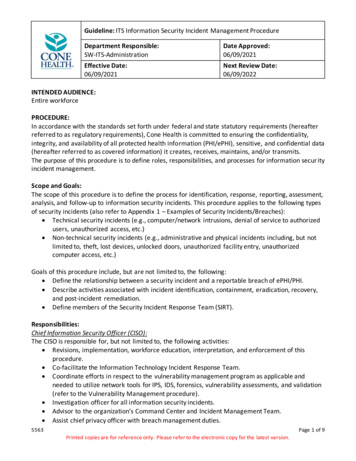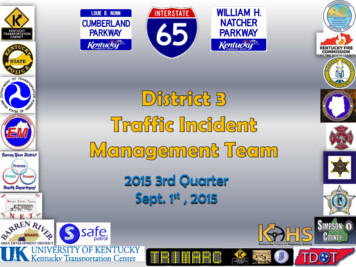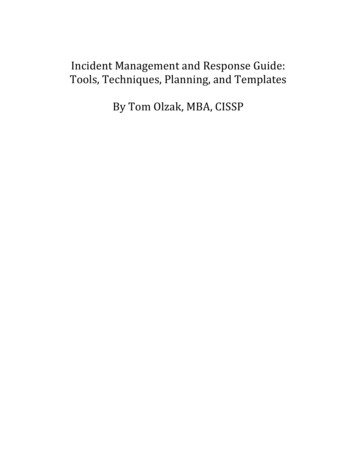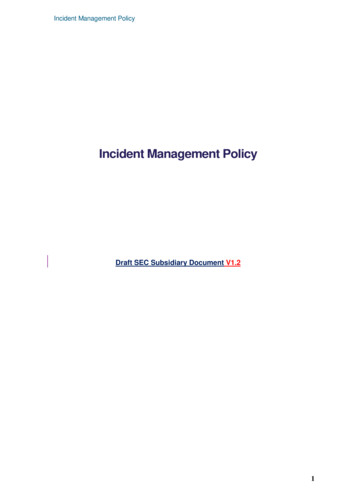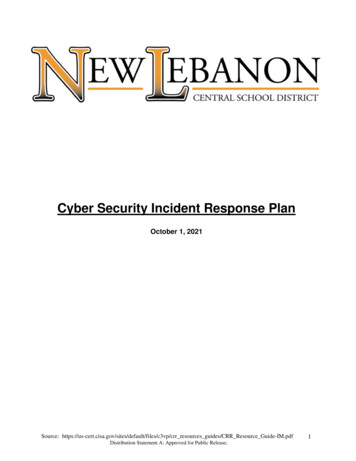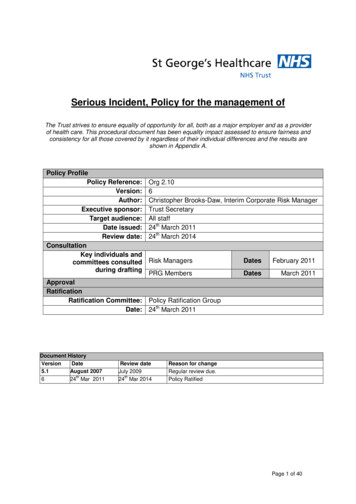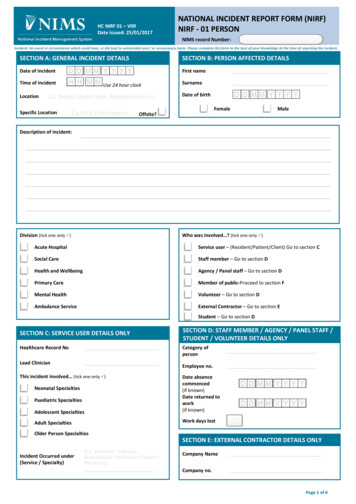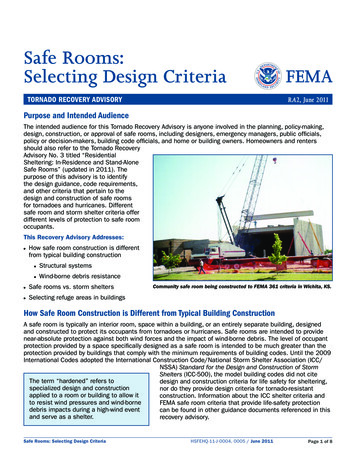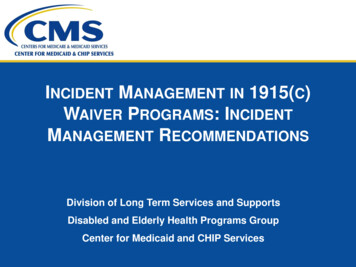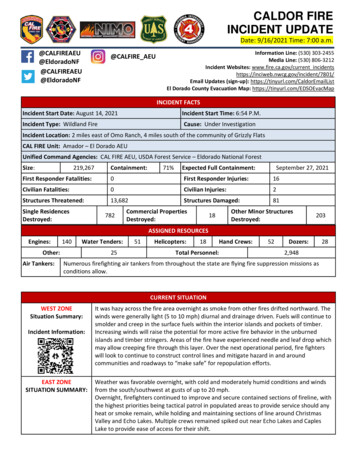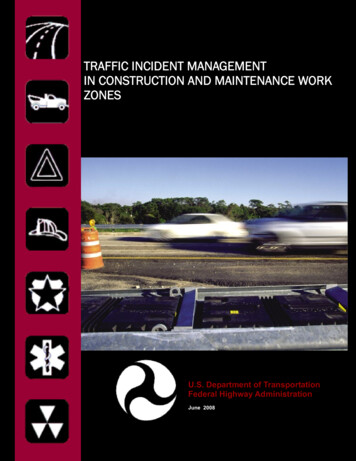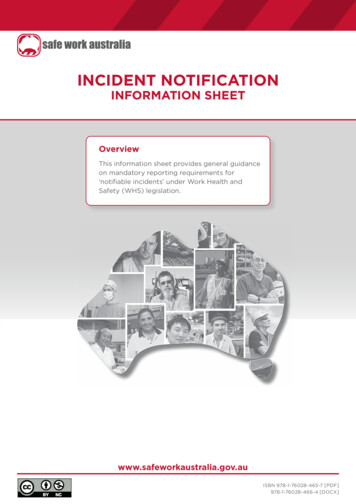
Transcription
INCIDENTNOTIFICATIONHeadingINFORMATION SHEETOverviewThis information sheet provides general guidanceon mandatory reporting requirements for‘notifiable incidents’ under Work Health andSafety (WHS) legislation.www.safeworkaustralia.gov.auISBN 978-1-76028-465-7 [PDF]978-1-76028-466-4 [DOCX]
Businesses and undertakings must notify theirwork health and safety regulator of certain‘notifiable incidents’ at work. This informationsheet will help you decide when you need tonotify the regulator of a work-related death,injury, illness or dangerous incident.Work health and safety regulators arecommitted to preventing work-relateddeaths and injuries. Notifying the regulator of‘notifiable incidents’ can help identify causesof incidents and prevent similar incidents atyour workplace and other workplaces.The WHS law requires: a ‘notifiable incident’ to be reported tothe regulator immediately after becomingaware it has happened if the regulator asks—written notificationwithin 48 hours of the request, and the incident site to be preserved untilan inspector arrives or directs otherwise(subject to some exceptions).Failing to report a ‘notifiable incident’ is anoffence and penalties apply.What is a ‘notifiable incident’A ‘notifiable incident’ is: the death of a person a ‘serious injury or illness’, or a ‘dangerous incident’arising out of the conduct of a business orundertaking at a workplace.‘Notifiable incidents’ may relate to anyperson—whether an employee, contractor ormember of the public.Serious injury or illnessOnly the most serious health or safetyincidents are notifiable, and only if they arework-related. They trigger requirements topreserve the incident site pending furtherdirection from the regulator.Serious injury or illness must be notified if theperson requires any of the types of treatmentin the following table:Types of treatmentExampleImmediate treatmentas an in-patient in ahospitalAdmission into a hospital as an in-patient for any duration, evenif the stay is not overnight or longer.It does not include:Out-patient treatment provided by the emergency section ofa hospital (i.e. not requiring admission as an in-patient)Admission for corrective surgery which does not immediatelyfollow the injury (e.g. to fix a fractured nose).Immediate treatment forthe amputation of anypart of the bodyAmputation of a limb such as arm or leg, body part such as hand,foot or the tip of a finger, toe, nose or ear.Immediate treatment fora serious head injuryFractured skull, loss of consciousness, blood clot or bleedingin the brain, damage to the skull to the extent that it is likely toaffect organ/face function.Head injuries resulting in temporary or permanent amnesia.It does not include:A bump to the head resulting in a minor contusion or headache.www.safeworkaustralia.gov.auNOVEMBER 2015 Page: 2
Types of treatmentExampleImmediate treatment fora serious eye injuryInjury that results in or is likely to result in the loss of the eye ortotal or partial loss of vision.Injury that involves an object penetrating the eye (for examplemetal fragment, wood chip).Exposure of the eye to a substance which poses a risk of seriouseye damage.It does not include:Eye exposure to a substance that merely causes irritation.Immediate treatment fora serious burnA burn requiring intensive care or critical care which could requirecompression garment or a skin graft.It does not include:A burn that merely requires washing the wound and applyinga dressing.Immediate treatmentfor the separation ofskin from an underlyingtissue (such as degloving or scalping)Separation of skin from an underlying tissue such that tendon, boneor muscles are exposed (de-gloving or scalping).Immediate treatment fora spinal injuryInjury to the cervical, thoracic, lumbar or sacral vertebrae includingthe discs and spinal cord.It does not include:Minor lacerations.It does not include:Acute back strain.Immediate treatmentfor the loss of a bodilyfunctionLoss of consciousness, loss of movement of a limb or loss of thesense of smell, taste, sight or hearing, or loss of function of aninternal organ.It does not include:Mere faintingA sprain or strain.Immediate treatment forserious lacerationsDeep or extensive cuts that cause muscle, tendon, nerve or bloodvessel damage or permanent impairment.Deep puncture wounds.Tears of wounds to the flesh or tissues—this may include stitchingto prevent loss of blood and/or other treatment to prevent loss ofbodily function and/or infection.www.safeworkaustralia.gov.auNOVEMBER 2015 Page: 3
Types of treatmentExampleMedical treatment within ‘Medical treatment’ is treatment provided by a doctor.48 hours of exposure toExposure to a substance includes exposure to chemicals, airbornea substancecontaminants and exposure to human and/or animal blood andbody substances.Notification is also required for the followingserious illnesses: Any infection where the work is asignificant contributing factor. Thisincludes any infection related to carryingout work:(i) with micro-organisms(ii) that involves providing treatment orcare to a person(iii) that involves contact with humanblood or body substances(iv) that involves handling or contact withanimals, animal hides, skins, wool or hair,animal carcasses or animal waste products. The following occupational zoonosescontracted in the course of work involvinghandling or contact with animals, animalhides, skins, wool or hair, animal carcassesor animal waste products:Even if immediate treatment is not readilyavailable, for example because the incidentsite is rural or remote or because the relevantspecialist treatment is not available, thenotification must still be made.Still unsure?If you are still unsure about whether aparticular incident should be notified thencontact your regulator for advice or furtherguidance. Contact details are included below.Dangerous incidents including‘near misses’Some types of work-related dangerousincidents must be notified even if no-one isinjured. The regulator must be notified ofany incident in relation to a workplace thatexposes any person to a serious risk resultingfrom an immediate or imminent exposure to: an uncontrolled escape, spillage or leakageof a substance(i) Q fever(ii) Anthrax an uncontrolled implosion, explosion or fire(iii) Leptospirosis an uncontrolled escape of gas or steam(iv) Brucellosis(v) Hendra Virus an uncontrolled escape of a pressurisedsubstance(vi) Avian Influenza electric shock:(vii) Psittacosis. examples of electrical shock that are notnotifiableTreatment‘Immediate treatment’ means the kind ofurgent treatment that would be required for aserious injury or illness. It includes treatmentby a registered medical practitioner, aparamedic or registered nurse.‘Medical treatment’ refers to treatment by aregistered medical practitioner (a doctor).ŘŘ shock due to static electricityŘŘ ‘extra low voltage’ shock (i.e. arisingfrom electrical equipment less than orequal to 50V AC and less than or equalto 120V DC)ŘŘ defibrillators are used deliberatelyto shock a person for first aid ormedical reasonswww.safeworkaustralia.gov.auNOVEMBER 2015 Page: 4
examples of electrical shocks that arenotifiableŘŘ minor shock resulting from directcontact with exposed live electricalparts (other than ‘extra low voltage’)including shock from capacitivedischarge the fall or release from a height of anyplant, substance or thing the collapse, overturning, failure ormalfunction of, or damage to, anyplant that is required to be design oritem registered under the Work Healthand Safety Regulations, for example acollapsing crane the collapse or partial collapse of astructure the collapse or failure of an excavation orof any shoring supporting an excavation the inrush of water, mud or gas in workings,in an underground excavation or tunnel, or the interruption of the main system ofventilation in an underground excavation ortunnel.A dangerous incident includes both immediateserious risks to health or safety, and also a riskfrom an immediate exposure to a substancewhich is likely to create a serious risk to healthor safety in the future, for example asbestos orhazardous chemicals.Only work-related incidentsare notifiableTo be notifiable, an incident must arise out ofthe conduct of the business or undertaking.An incident is not notifiable just because ithappens at or near a workplace.Incidents may happen for reasons which donot have anything to do with work or theconduct of the business or undertaking,for example: a worker or another person suffers a heartattack while at work which is unrelatedto work or the conduct of the businessor undertaking an amateur athlete is injured while playing forthe local soccer team and requires immediatemedical treatment (this is not work) a person driving to work is injured in a caraccident (where driving is not partof their work) a person with epilepsy has a seizure atwork.These kinds of incidents are not notifiable.Work-related incidents that occuroutside a workplace may be notifiableWork-related incidents may affect peopleoutside the workplace. These may still benotifiable if they involve a death, serious illnessor injury or a dangerous incident.For example: an object like a hand tool falls off a multistorey building under construction hitting aperson below scaffold collapse that causes a risk ofserious injury to persons adjacent to aconstruction site an awning over a shop-front collapses,hitting a person underneath it.Appendix A provides more information aboutincidents at public places or sporting events.Who is responsiblefor notifying?Any person conducting a business orundertaking (PCBU) from which the ‘notifiableincident’ arises must ensure the regulator isnotified immediately after becoming aware ithas happened.Procedures should be put into place toensure work health and safety incidents arepromptly notified to the people responsible forresponding to them, for example a managerand then notified to the regulator, if required.Incidents involving multiplebusinesses or undertakingsIf a ‘notifiable incident’ arises out of more thanone business or undertaking then each mustensure that the incident has been notified tothe regulator.www.safeworkaustralia.gov.auNOVEMBER 2015 Page: 5
There is no need for all duty holders to notify—only one needs to. However, all duty holdersretain their responsibility to notify, regardlessof any agreement between them.In these circumstances the duty holdersmust, so far as is reasonably practicable,consult, cooperate and coordinate to putappropriate reporting and notificationarrangements in place.For example contractors at a constructionworkplace may agree that the principalcontractor for the workplace will notify all‘notifiable incidents’ that occur atthe workplace.Incidents involving a ‘Statebased contractor working for aCommonwealth entity’Workplaces shared by a Commonwealthentity and one or more state-basedcontractors may be covered by bothCommonwealth and state or territory workhealth and safety (WHS) laws.For example an asbestos removal companyis engaged by the Department of Defence(Defence) to carry out asbestos removalwork at Randwick Army Barracks in Sydneyand a dangerous incident occurs (as definedabove). Because the incident has occurredat a place where work is carried out forDefence (on behalf of the Commonwealth) thecompany must ensure that both Comcare andWorkCover NSW are notified of the incident.Defence and the company may co-operate sothat only one notification is made to Comcareon behalf of both.When and how to notifyYou must notify the regulator immediatelyafter becoming aware of a ‘notifiable incident’.The notice must be given by the fastestpossible means—which could be by telephoneor in writing, for example by email or online (ifavailable). See page 8 for contact details.Regulators have adopted a common-senseapproach to assessing whether an incidenthas been notified immediately. This meansincidents must be notified as soon as theparticular circumstances permit.In general a PCBU ‘becomes aware’ ofa notifiable incident once any of theirsupervisors or managers becomes awareof the incident. For example when a workersuffers a serious injury and reports it to theirimmediate supervisor, it is at this pointthat the PCBU is considered to be aware ofthe incident.It is therefore essential to develop internalcommunication systems to ensure health orsafety incidents are promptly brought to therelevant persons’ attention.What information will be requested?At first, the regulator will ask for a clear description of the incident with as much detail aspossible. This will help the regulator assess whether or not the incident is notifiable and theneed for a follow-up investigation. The following information is usually requested:What happened: anoverview Provide an overview of what happened. Nominate the type of notifiable incident—was it death,serious injury or illness, or ‘dangerous incident’ (as definedabove)?When did it happenDate and time.Where did it happenIncident address.Details that describe the specific location of the notifiableincident—for example section of the warehouse or the particularpiece of equipment that the incident involved—to assistinstructions about site disturbance.What happenedDetailed description of the notifiable incident.www.safeworkaustralia.gov.auINFORMATION SHEET — INCIDENT NOTIFICATIONNOVEMBER 2015 Page: 6
Who did it happen to Injured person’s name, date of birth, address and contactnumber. Injured person’s occupation. Relationship of the injured person to the entity notifying.How and where arethey being treated (ifapplicable) Description of serious injury or illness—i.e. nature of injuryWho is the personconducting the businessor undertaking (there maybe more than one) Legal and trading name. Initial treatment of serious injury or illness. Where the patient has been taken for treatment.What has/is being done Business address (if different from incident address), ABN/ACN and contact details including phone number and email.Action taken or intended to be taken to prevent recurrence (if any).Who is notifying Notifier’s name, contact phone number and position atworkplace. Name, phone number and position of person to contactfor further information (if different from above).Notify immediately, and provide theinformation you can, even if you do not haveall of the required information.The regulator may follow-up with a request formore information later if necessary. You mustprovide the required information in writingwithin 48 hours of the request being made.Can work continue where theincident occurred?An incident site must not be disturbed untilan inspector arrives at the site or directsotherwise (whichever is earlier). The personwith management or control of the workplaceis responsible for preserving the incident site,so far as is reasonably practicable.Any evidence that may assist an inspector todetermine the cause of the incident must bepreserved—including any plant, substance,structure or thing associated with the incident.However, preserving an incident site does notprevent any action needed: to assist an injured person to remove a deceased person to make the site safe or to minimise the riskof a further notifiable incident, orThe sooner the regulator is notified, thesooner the site can be released.An inspector may issue a non-disturbancenotice, if they consider that the incidentsite should remain undisturbed in order tofacilitate their investigation. This notice mustspecify the period for which the notice is toapply—no more than seven days.Penalties apply if an individual or bodycorporate fails to preserve a site.Site preservation requirements onlyapply to the incident siteRequirements to preserve a site only apply tothe area where the incident occurred—not thewhole workplace.If you are unsure about what you need to do,you can ask the regulator for advice or to beexcused from having to preserve the site.Amending notificationsIf you receive information that changes theincident type of a notified incident, youmust notify the regulator of those changes.For example, if a notified serious injury orillness later results in the person’s death, theregulator must be advised immediately uponyou learning that the person has died. to facilitate a police investigation.www.safeworkaustralia.gov.auNOVEMBER 2015 Page: 7
Record keeping requirementsRecords of notifiable incidents must bekept for at least five years from the date ofnotification. Penalties apply for failing to do so.It is useful to keep a record of having madethe notification (e.g. confirmation fromthe regulator), and also any directions orauthorisations given by an inspector at thetime of notification.Contact details for regulatorsTo notify a ‘notifiable incident’ contact your local regulator:JurisdictionRegulatorTelephoneWebsiteNew SouthWalesSafeWork NSW13 10 50safework.nsw.gov.auVictoriaWorkSafe Victoria1800 136 089worksafe.vic.gov.auQueenslandWorkSafe Queensland 1300 369 915worksafe.qld.gov.auSouth AustraliaSafeWork SA1800 777 209safework.sa.gov.auWesternAustraliaWorkSafe WA1300 307 ritoryWorkSafe ACT02 6207 fe Tasmania1300 366 322 (Tas) worksafe.tas.gov.au03 6233 7657(External)NorthernTerritoryNT WorkSafeCommonwealth Comcare1800 019 115worksafe.nt.gov.au1300 366 BER 2015 Page: 8
Appendix AIncidents during sports activitiesPublic places and sporting eventsWork health and safety duties apply in relationto professional sports people for whom sportis work and sport organised by businessesor undertakings. They do not apply to purelysocial or recreational activities or activitiesorganised by wholly volunteer associationsthat do not employ anyone.Workplaces may also be public or partly publicplaces, for example: public parks, streets public transport shopping centres sports facilities schools and colleges aged care facilities, hospitals and medicalcentres cafes, restaurants, hotels and other kindsof public accommodation.Incidents involving bystanders, visitors,students, patrons or other members of thepublic are only notifiable if:For more information about the way the workhealth and safety laws affect volunteers andorganisations with volunteers refer to theonline resource kit published by Safe WorkAustralia.Some sports injuries may arise from ‘work’(for example a professional AFL footballer)while others may not (a local amateur clubfootballer). there is a deathSports injuries are not notifiable if arising outof the normal conduct of a sports activity forexample rough and tumble of a game. a ‘serious injury or illness’ is suffered orthere is a dangerous incident (‘near miss’as described above), andSports injuries are notifiable only if arising outof the conduct of a business or undertakingfor example: the incident arises out of the conductof a business or undertaking.An incident may arise out of the conductof a business or undertaking for examplebecause of: the way a work activity is organised (forexample inadequate safety precautions) the way equipment or substances are used(for example lifts, machinery) the condition of a workplace (for examplepoorly maintained or slippery floors) actions of someone who is not a workerat the workplace.If a visitor at a shopping centre is taken tohospital after sustaining a serious fracture thenthe incident would be notifiable. If a visitor istaken to hospital because of their pre-existingmedical condition (for example heart attack,epileptic seizure at a shop) this would not benotifiable as it did not result from the conductof the business or undertaking. the way a work activity involving sport isarranged the way the sporting activity is managedor controlled the condition, design or maintenance ofpremises or equipment, or the way work is carried out, for exampleinadequate supervision.Examples of notifiable incidents include: the condition of the premises or sportsequipment was a factor in the incident—forexample where a participant suffers aninjury requiring admission as an inpatientat a hospital due to tripping over on apotholed tarmac surface, or there was inadequate supervision toprevent an incident—like ensuring thesafe use of equipment used by studentson a school excursion or failings in theorganisation and management of an event.www.safeworkaustralia.gov.auNOVEMBER 2015 Page: 9
Failing to report a 'notifiable incident' is an offence and penalties apply. What is a 'notifiable incident' A 'notifiable incident' is: the death of a person a 'serious injury or illness', or a 'dangerous incident' arising out of the conduct of a business or undertaking at a workplace.
